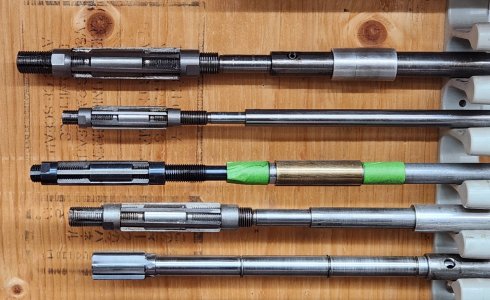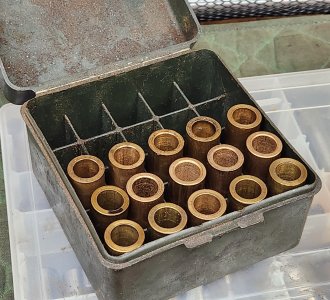I've done that for a couple of other similar jobs, but not worth the time to set it up for shotgun barrels, and then re tramming the mill back.could you do the same with the mill? i've seen guys mount long stuff kind of off the side of the table so it extends downward
-
Scam Alert. Members are reminded to NOT send money to buy anything. Don't buy things remote and have it shipped - go get it yourself, pay in person, and take your equipment with you. Scammers have burned people on this forum. Urgency, secrecy, excuses, selling for friend, newish members, FUD, are RED FLAGS. A video conference call is not adequate assurance. Face to face interactions are required. Please report suspicions to the forum admins. Stay Safe - anyone can get scammed.
You are using an out of date browser. It may not display this or other websites correctly.
You should upgrade or use an alternative browser.
You should upgrade or use an alternative browser.
Tool Chucking Reamers
- Thread starter Susquatch
- Start date
Tool
ChazzC
Ultra Member
Well, maybe: I did some more searching and finally found one of James's (Clough42) videos where he does mention this after reaming a deep 12mm hole (video is set to start at the beginning of the drilling so you can see his entire process):I thought it was the other way around, that coolant would produce a tighter hole than cutting oil.??
James does mention that the thin vs thick & smaller vs larger reamed hole subject could be the topic of a separate video, so I'll give him a poke on his Discourse page and see if he'll do the follow-up. I also tried searching Steffan's videos, but haven't found where he makes a comment about this.
And maybe the answer is, "....it depends". Maybe when you use coolant, the resulting reamed hole will be to dimension, but when using oil, it doesn't cool the material, the material expands due to heat, and when the material gets back to room temperature it has shrunk just slightly. Or maybe, with heat, the reamer itself expands, and cuts a closer dimension. And if its temperature related, what about different materials' rate of expansion vs the reamers'.Well, maybe: I did some more searching and finally found one of James's (Clough42) videos where he does mention this after reaming a deep 12mm hole (video is set to start at the beginning of the drilling so you can see his entire process):
James does mention that the thin vs thick & smaller vs larger reamed hole subject could be the topic of a separate video, so I'll give him a poke on his Discourse page and see if he'll do the follow-up. I also tried searching Steffan's videos, but haven't found where he makes a comment about this.
Or if its not heat realated, maybe the oil creates some sort of molecular boundary layer that creates a slightly larger hole.
All I know is to,
"...never get involved in a land war in Asia.’
Vizzini The Sicilian
ChazzC
Ultra Member
I just finished adding a topic to James's Discourse asking that he make a video exploring the question. I am also continuing to search Stefan's videos to see what he thinks (may just email him).And maybe the answer is, "....it depends". Maybe when you use coolant, the resulting reamed hole will be to dimension, but when using oil, it doesn't cool the material, the material expands due to heat, and when the material gets back to room temperature it has shrunk just slightly. Or maybe, with heat, the reamer itself expands, and cuts a closer dimension. And if its temperature related, what about different materials' rate of expansion vs the reamers'.
Or if its not heat realated, maybe the oil creates some sort of molecular boundary layer that creates a slightly larger hole.
All I know is to,
"...never get involved in a land war in Asia.’
Vizzini The Sicilian
historicalarms
Ultra Member
Just spit-balling here...are not all shotgun barrels almost universaly "hard chrome lined" these days....could be what causes the "chatter on the first pass and it seems that once chatter starts every pass afterwards follows the chatter path. Single point reaming might be the only way to get from a chatter surface to a smooth surface.
Not all barrels are. I usually do older doubles. But for the chrome lined ones, I have brazed carbide exanding reamers in 12g. For the other gauges I hone out the choke area to remove the plating before I start reaming.Just spit-balling here...are not all shotgun barrels almost universaly "hard chrome lined" these days....could be what causes the "chatter on the first pass and it seems that once chatter starts every pass afterwards follows the chatter path. Single point reaming might be the only way to get from a chatter surface to a smooth surface.
In the photos, you'll see some of the shotgun expanding reamers, a box of 12g. bronze bushings in 0.002" increments for the bore ( I have bushings for 16g and 20g as well) and the Sunnen portable hone.
And yes, once the chatter starts, you have to go in and hone it smooth before you continue, otherwise it gets worse.
Attachments
And yes, once the chatter starts, you have to go in and hone it smooth before you continue, otherwise it gets worse.
I occasionally wrapped the reamer in paper and restarted it when chatter starts. If you catch it right away, it will usually clean up the surface enough to cut normally again. I don't remember where I got this idea from but I can say that it has worked for me.
ChazzC
Ultra Member
I think Guy Lautard mentioned using waxed paper in one of the Bedside Readers.I occasionally wrapped the reamer in paper and restarted it when chatter starts. If you catch it right away, it will usually clean up the surface enough to cut normally again. I don't remember where I got this idea from but I can say that it has worked for me.
EDIT: Waxed paper for chambering reamers - TMBR #1, page 16, which points to Brownells Gunsmith Kinks #2, page 290.
Last edited:
DPittman
Ultra Member
So I have very few adjustable reamers and actually never used one - but I just ordered a full set from aliexpress - we see how good or terrible they are.
I have some Asian made ones in smaller sizes (smaller than 12mm) and they are pure garbage. I have a couple larger ones (15-17mm) and they are acceptable but NOWHERE near the quality of my USA made ones. The angled blade ones help reduce chatter if you can find them.
Tom Kitta
Ultra Member
I have some Asian made ones in smaller sizes (smaller than 12mm) and they are pure garbage. I have a couple larger ones (15-17mm) and they are acceptable but NOWHERE near the quality of my USA made ones. The angled blade ones help reduce chatter if you can find them.
OK, we see whatever quality improved. The non-adjustable stuff from China I got is quite usable. Not great but certainly not garbage - of note is that I do not have precision stuff to actually check the sizing of small holes.
I think Guy Lautard mentioned using waxed paper in one of the Bedside Readers.
EDIT: Waxed paper for chambering reamers - TMBR #1, page 16, which points to Brownells Gunsmith Kinks #2, page 290.
Yes. Waxed paper is better. But even regular paper works.
DPittman
Ultra Member
I ain't no expert, so take it for what it's worth... I simply make small adjustments until the reamer starts to cut and then measure and then incrementally adjust upwards. Remember you can only take off very small amounts at once so overshooting your hole size isn't easy.Those who use adjustable reamers....What's your technique for confirming that they are set to the size you want them to be? I mean, kinda the potential problem with adjustable reamers is that they are, you know, "adjustable"...
Tom Kitta
Ultra Member
So how exactly does one measure the size of the reamer - size it will cut? Basic idea is just to at least use calipers and measure the distance between blades, but that seems to be rather... not so accurate. Even for fixed size reamers, where the size of the reamer has worn off I am finding it hard to figure out what the size should be. Is there some kind of a trick one can use? For example, When I measure close to 0.5in I am unsure as whatever it is 0.5 or 0.501 or 0.499 - heck it could be as well 0.497.
So how exactly does one measure the size of the reamer - size it will cut?
Can't really help Tom, but it seems rather obvious to me that it won't be LESS than the measurement across blades assuming your measuring device is decent. I would not use calipers for that task. Even the really good ones can be out +/-5 or more tenths just rounding. Given that reamers can be a few tenths one way or the other, calipers are simply inadequate.
It's trial and error (hopefully no error. The blades have a very slight tapered section on the front for ease of entry, then parrallel section in the center, and then slight back taper in the rear section.
Measure your existing hole. Adjust it smaller, go into your hole, increase 1/4 turn at a time until it starts to feel snug at the center section of the reamer. Expand 1/8 - 1/4 turn until it starts to bite go completely through and measure your new reamed hole and make a correlation between the amount you expanded reamer and the amount it removed.
Keep it straight, use good dark cutting oil.
Prayers seem to help at times, unless you're a sinner. Then there's no hope for you
Measure your existing hole. Adjust it smaller, go into your hole, increase 1/4 turn at a time until it starts to feel snug at the center section of the reamer. Expand 1/8 - 1/4 turn until it starts to bite go completely through and measure your new reamed hole and make a correlation between the amount you expanded reamer and the amount it removed.
Keep it straight, use good dark cutting oil.
Prayers seem to help at times, unless you're a sinner. Then there's no hope for you
Prayers seem to help at times, unless you're a sinner. Then there's no hope for you
Welp, there goes that idea.
I routinely bomb on the 10th commandment about covetting another man's wife. Mind you, I think that's really aimed at jealousy. In my case I'm not really jealous, I'm actually more like breaking the 7th and committing adultery in my mind. The other guy can keep her.
Ya, no adjustable reamers in my future then.




